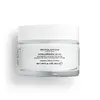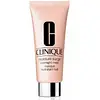What's inside
What's inside
 Key Ingredients
Key Ingredients

 Benefits
Benefits

 Concerns
Concerns

 Ingredients Side-by-side
Ingredients Side-by-side

Water
Skin ConditioningGlycerin
HumectantPropylene Glycol
HumectantCetyl Alcohol
EmollientDimethicone
EmollientPrunus Amygdalus Dulcis Oil
Skin ConditioningSorbitan Stearate
EmulsifyingPentaerythrityl Tetraisostearate
EmollientGlyceryl Stearate
EmollientPEG-100 Stearate
Phenoxyethanol
PreservativePolyacrylamide
C13-14 Isoparaffin
EmollientEthylhexylglycerin
Skin ConditioningSodium Hyaluronate
HumectantTocopheryl Acetate
AntioxidantLaureth-7
EmulsifyingAloe Barbadensis Leaf Juice Powder
Skin ConditioningDisodium EDTA
Sodium Hydroxide
BufferingWater, Glycerin, Propylene Glycol, Cetyl Alcohol, Dimethicone, Prunus Amygdalus Dulcis Oil, Sorbitan Stearate, Pentaerythrityl Tetraisostearate, Glyceryl Stearate, PEG-100 Stearate, Phenoxyethanol, Polyacrylamide, C13-14 Isoparaffin, Ethylhexylglycerin, Sodium Hyaluronate, Tocopheryl Acetate, Laureth-7, Aloe Barbadensis Leaf Juice Powder, Disodium EDTA, Sodium Hydroxide
Water
Skin ConditioningGlycerin
HumectantCetyl Alcohol
EmollientDimethicone
EmollientGlyceryl Polymethacrylate
Butyrospermum Parkii Butter
Skin ConditioningCetyl Ethylhexanoate
EmollientPEG-8
HumectantGlycereth-26
HumectantSucrose
HumectantSorbitan Stearate
EmulsifyingPEG-100 Stearate
Trehalose
HumectantMangifera Indica Seed Butter
Skin ConditioningHypnea Musciformis Extract
Skin ProtectingGelidiella Acerosa Extract
Skin ProtectingOlea Europaea Fruit Extract
BleachingTriticum Vulgare Bran Extract
Skin ConditioningCladosiphon Okamuranus Extract
Skin ConditioningAstrocaryum Murumuru Seed Butter
EmollientCetearyl Alcohol
EmollientAloe Barbadensis Leaf Water
MaskingPEG-75
HumectantCaffeine
Skin ConditioningPantethine
EmollientSorbitol
HumectantButylene Glycol
HumectantOryzanol
Skin ConditioningBisabolol
MaskingPanthenol
Skin ConditioningPhytosterols
Skin ConditioningTocopheryl Acetate
AntioxidantCaprylyl Glycol
EmollientSodium Hyaluronate
HumectantHexylene Glycol
EmulsifyingCarbomer
Emulsion StabilisingPotassium Hydroxide
BufferingDextrin
AbsorbentDisodium EDTA
Phenoxyethanol
PreservativeCI 14700
Cosmetic ColorantCI 19140
Cosmetic ColorantWater, Glycerin, Cetyl Alcohol, Dimethicone, Glyceryl Polymethacrylate, Butyrospermum Parkii Butter, Cetyl Ethylhexanoate, PEG-8, Glycereth-26, Sucrose, Sorbitan Stearate, PEG-100 Stearate, Trehalose, Mangifera Indica Seed Butter, Hypnea Musciformis Extract, Gelidiella Acerosa Extract, Olea Europaea Fruit Extract, Triticum Vulgare Bran Extract, Cladosiphon Okamuranus Extract, Astrocaryum Murumuru Seed Butter, Cetearyl Alcohol, Aloe Barbadensis Leaf Water, PEG-75, Caffeine, Pantethine, Sorbitol, Butylene Glycol, Oryzanol, Bisabolol, Panthenol, Phytosterols, Tocopheryl Acetate, Caprylyl Glycol, Sodium Hyaluronate, Hexylene Glycol, Carbomer, Potassium Hydroxide, Dextrin, Disodium EDTA, Phenoxyethanol, CI 14700, CI 19140
 Reviews
Reviews

Ingredients Explained
These ingredients are found in both products.
Ingredients higher up in an ingredient list are typically present in a larger amount.
Cetyl Alcohol is a fatty alcohol. Fatty Alcohols are most often used as an emollient or to thicken a product.
Its main roles are:
Though it has "alcohol" in the name, it is not related to denatured alcohol or ethyl alcohol.
The FDA allows products labeled "alcohol-free" to have fatty alcohols.
Learn more about Cetyl AlcoholDimethicone is a type of synthetic silicone created from natural materials such as quartz.
What it does:
Dimethicone comes in different viscosities:
Depending on the viscosity, dimethicone has different properties.
Ingredients lists don't always show which type is used, so we recommend reaching out to the brand if you have questions about the viscosity.
This ingredient is unlikely to cause irritation because it does not get absorbed into skin. However, people with silicone allergies should be careful about using this ingredient.
Note: Dimethicone may contribute to pilling. This is because it is not oil or water soluble, so pilling may occur when layered with products. When mixed with heavy oils in a formula, the outcome is also quite greasy.
Learn more about DimethiconeDisodium EDTA plays a role in making products more stable by aiding other preservatives.
It is a chelating agent, meaning it neutralizes metal ions that may be found in a product.
Disodium EDTA is a salt of edetic acid and is found to be safe in cosmetic ingredients.
Learn more about Disodium EDTAGlycerin is already naturally found in your skin. It helps moisturize and protect your skin.
A study from 2016 found glycerin to be more effective as a humectant than AHAs and hyaluronic acid.
As a humectant, it helps the skin stay hydrated by pulling moisture to your skin. The low molecular weight of glycerin allows it to pull moisture into the deeper layers of your skin.
Hydrated skin improves your skin barrier; Your skin barrier helps protect against irritants and bacteria.
Glycerin has also been found to have antimicrobial and antiviral properties. Due to these properties, glycerin is often used in wound and burn treatments.
In cosmetics, glycerin is usually derived from plants such as soybean or palm. However, it can also be sourced from animals, such as tallow or animal fat.
This ingredient is organic, colorless, odorless, and non-toxic.
Glycerin is the name for this ingredient in American English. British English uses Glycerol/Glycerine.
Learn more about GlycerinPeg-100 Stearate is an emollient and emulsifier. As an emollient, it helps keep skin soft by trapping moisture in. On the other hand, emulsifiers help prevent oil and water from separating in a product.
PEGS are a hydrophilic polyether compound . There are 100 ethylene oxide monomers in Peg-100 Stearate. Peg-100 Stearate is polyethylene glycol ester of stearic acid.
Phenoxyethanol is a preservative that has germicide, antimicrobial, and aromatic properties. Studies show that phenoxyethanol can prevent microbial growth. By itself, it has a scent that is similar to that of a rose.
It's often used in formulations along with Caprylyl Glycol to preserve the shelf life of products.
Sodium Hyaluronate is hyaluronic acid's salt form. It is commonly derived from the sodium salt of hyaluronic acid.
Like hyaluronic acid, it is great at holding water and acts as a humectant. This makes it a great skin hydrating ingredient.
Sodium Hyaluronate is naturally occurring in our bodies and is mostly found in eye fluid and joints.
These are some other common types of Hyaluronic Acid:
Learn more about Sodium HyaluronateSorbitan Stearate comes from sorbitol and stearic acid. Sorbitol is a type of sugar and stearic acid is a fatty acid.
It is used as an emulsifier and helps ingredients stay together by creating water-in-oil emulsions.
This ingredient may not be Malassezia folliculitis, or fungal-acne safe.
Tocopheryl Acetate is AKA Vitamin E. It is an antioxidant and protects your skin from free radicals. Free radicals damage the skin by breaking down collagen.
One study found using Tocopheryl Acetate with Vitamin C decreased the number of sunburned cells.
Tocopheryl Acetate is commonly found in both skincare and dietary supplements.
Learn more about Tocopheryl AcetateWater. It's the most common cosmetic ingredient of all. You'll usually see it at the top of ingredient lists, meaning that it makes up the largest part of the product.
So why is it so popular? Water most often acts as a solvent - this means that it helps dissolve other ingredients into the formulation.
You'll also recognize water as that liquid we all need to stay alive. If you see this, drink a glass of water. Stay hydrated!
Learn more about Water